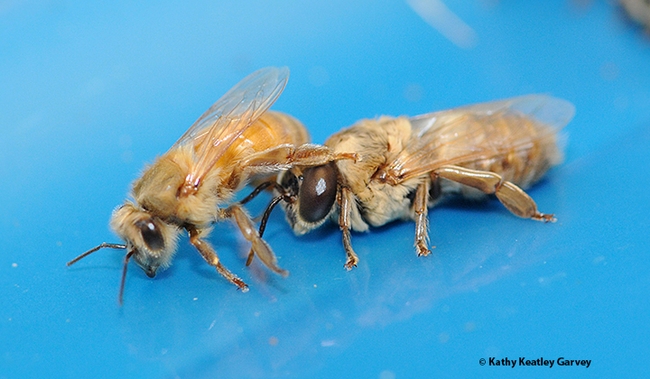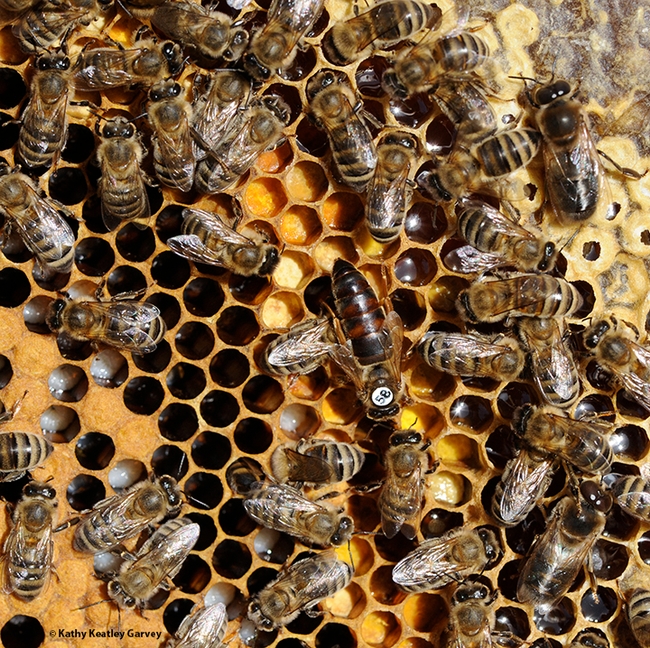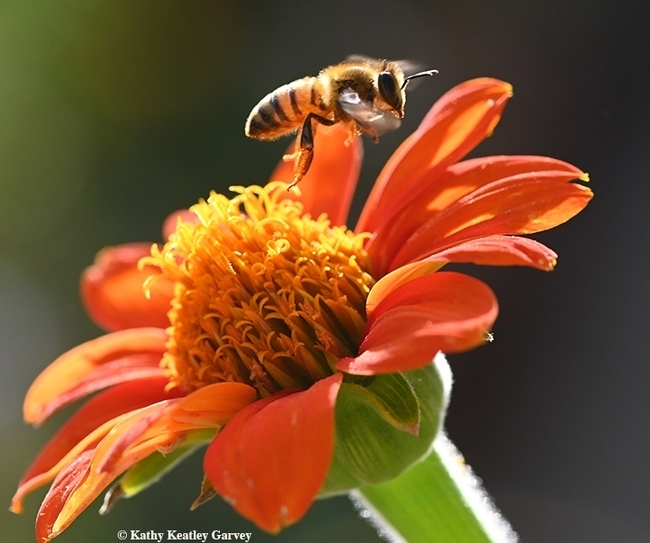If you haven't been around honey bees much, and can't distinguish the queen from a worker bee (sterile female) or drone (male bee), head over the California Master Beekeeper Program displays at the California Honey Festival on Saturday between 10 a.m. and 5 p.m. in downtown Woodland.
You can watch the bees in a glassed-in observation hive: the three castes, the queen, the workers and the drones.
In peak season, a queen can lay from 1000 to 2000 eggs a day.
It's a matriarchial society and the workers (females) do all the work. The workers' age-related specific duties include nurse maids, nannies, royal attendants, builders, architects, foragers, dancers, honey tenders, pollen packers, propolis or "glue" specialists, air conditioning and heating technicians, guards, and undertakers. The worker bees run the hive.
The California Master Beekeeper Program (CAMPB), directed by Extension apiculturst Elina Lastro Niño of the UC Davis Department of Entomology and Nematoogy, is a "continuous train-the-trainer effort," as its website indicates. "The CAMBP's vision is to train Apprentice, Journey and Master level beekeepers so they can effectively communicate the importance of honey bees and other pollinators within their communities, serve as mentors for other beekeepers, and become the informational conduit between the beekeeping communities throughout the state and UC Cooperative Extension staff."
This is science-based education! This is not Jerry Seinfeld's Bee Movie in which bee misinformation reigns supreme. The scenario: "Barry B. Benson, a bee just graduated from college, is disillusioned at his lone career choice: making honey. On a special trip outside the hive, Barry's life is saved by Vanessa, a florist in New York City. As their relationship blossoms, he discovers humans actually eat honey, and subsequently decides to sue them."
The most egregious error: male bees have nothing to do with making honey or finding flowers or running the hive. Zero. Zilch. Nada.
The drone's sole task is to mate with a virgin queen and then he dies. Any drones left in the hive by the end of the season (late fall, early winter) get kicked out by their sisters. They're just another mouth to feed. The gals don't want to deplete their precious resources.
The California Honey Festival, launched in 2017, is a good place to learn about bees and honey. Admission is free.
Some of the activities:
- The UC Davis Honey and Pollination Center will showcase its honey tasting wheel and offer free honey tasting.
- The California Master Beekeeper Program will staff two educational booths. Visitors can examine a bee observation hive, check out the beekeeping equipment and peer through microscopes. Kids' activities are also planned.
- The Bohart Museum of Entomology of the UC Davis Department of Entomology and Nematolgoy will showcase bee diversity in its specimen drawers. Its live "petting zoo" will include Madagascar hissing cockroaches and stick insects (walking sticks) that folks can hold, said Tabatha Yang, education and outreach coordinator.
- The UC Davis Arboretum and Public Garden will address pollinator needs and gardening.
- The Woodland Public Library will offer a children's reading hour.
- Uncle Jer's Traveling Bee Show will provide educational performances.
- The UC Davis Bookstores booth will contain honey, books, and other gifts for sale.
Amina Harris, director of the UC Davis Honey and Pollination Center, and a co-founder of the California Honey Festival, says 100 vendors will sell everything from food to plants to arts and crafts. Visitors can don a bee costume and get their picture taken in the UC Davis Pollination Park, a collaboration with the UC Davis Arboretum and Public Garden.
An after-party is planned at The Hive, part of Z Specialty Food, Woodland. Harris, the "Queen Bee" of Z Specialty Food, said advance registration is required. Access https://zspecialtyfood.com/event/california-honey-festival-after-party/.
Attached Images:

The worker bee (sterile female) is at left, and the drone (male) is at right. (Photo by Kathy Keatley Garvey)

Can you find the queen, the workers and the drones? (Photo by Kathy Keatley Garvey)

Worker bees are sterile females. Here a worker bee (forager) leaves a Mexican sunflower, Tithonia rotundifola. (Photo by Kathy Keatley Garvey)